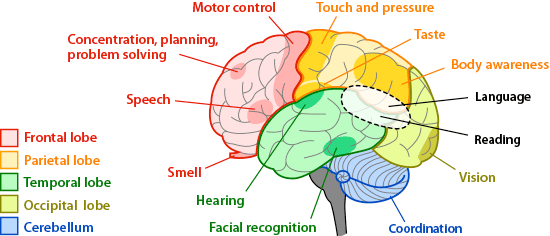The human brain allows humans to successfully interact with their environment, by communicating with others and interacting with inanimate objects near their position. If the brain is not functioning properly, the ability to move, generate accurate sensory information or speak and understand language can be damaged as well.
The brain is made up of nerve cells which interact with the rest of the body through the spinal cord and nervous system. These cells relate information back to specific centers of the brain where it can be processed and an appropriate reaction can be generated. Several chemicals are also located in the brain, which help the body maintain homeostasis, or a sense of overall comfort and calm as its basic needs are met. Keeping these chemicals balanced and the nerve cells firing properly are essential to healthy brain function.

Parts of the Brain and Their Functions
Cerebrum
The cerebrum is the largest portion of the brain, and contains tools which are responsible for most of the brain's function. It is divided into four sections: the temporal lobe, the occipital lobe, parietal lobe and frontal lobe. The cerebrum is divided into a right and left hemisphere which are connected by axons that relay messages from one to the other. This matter is made of nerve cells which carry signals between the organ and the nerve cells which run through the body.
Frontal Lobe: The frontal lobe is one of four lobes in the cerebral hemisphere. This lobe controls a several elements including creative thought, problem solving, intellect, judgment, behavior, attention, abstract thinking, physical reactions, muscle movements, coordinated movements, smell and personality.
Parietal Lobe:Located in the cerebral hemisphere, this lobe focuses on comprehension. Visual functions, language, reading, internal stimuli, tactile sensation and sensory comprehension will be monitored here.
- Sensory Cortex- The sensory cortex, located in the front portion of the parietal lobe, receives information relayed from the spinal cord regarding the position of various body parts and how they are moving. This middle area of the brain can also be used to relay information from the sense of touch, including pain or pressure which is affecting different portions of the body.
- Motor Cortex- This helps the brain monitor and control movement throughout the body. It is located in the top, middle portion of the brain.
- Temporal Lobe: The temporal lobe controls visual and auditory memories. It includes areas that help manage some speech and hearing capabilities, behavioral elements, and language. It is located in the cerebral hemisphere.
- Wernicke's Area- This portion of the temporal lobe is formed around the auditory cortex. While scientists have a limited understanding of the function of this area, it is known that it helps the body formulate or understand speech.
Occipital Lobe: The optical lobe is located in the cerebral hemisphere in the back of the head. It helps to control vision.
- Broca's Area- This area of the brain controls the facial neurons as well as the understanding of speech and language. It is located in the triangular and opercular section of the inferior frontal gyrus.
Cerebellum
This is commonly referred to as "the little brain," and is considered to be older than the cerebrum on the evolutionary scale. The cerebellum controls essential body functions such as balance, posture and coordination, allowing humans to move properly and maintain their structure.
Limbic System
The limbic system contains glands which help relay emotions. Many hormonal responses that the body generates are initiated in this area. The limbic system includes the amygdala, hippocampus, hypothalamus and thalamus.
Amygdala:The amygdala helps the body responds to emotions, memories and fear. It is a large portion of the telencephalon, located within the temporal lobe which can be seen from the surface of the brain. This visible bulge is known as the uncus.
Hippocampus: This portion of the brain is used for learning memory, specifically converting temporary memories into permanent memories which can be stored within the brain. The hippocampus also helps people analyze and remember spatial relationships, allowing for accurate movements. This portion of the brain is located in the cerebral hemisphere.
Hypothalamus:The hypothalamus region of the brain controls mood, thirst, hunger and temperature. It also contains glands which control the hormonal processes throughout the body.
Thalamus:The Thalamus is located in the center of the brain. It helps to control the attention span, sensing pain and monitors input that moves in and out of the brain to keep track of the sensations the body is feeling.
Brain Stem
All basic life functions originate in the brain stem, including heartbeat, blood pressure and breathing. In humans, this area contains the medulla, midbrain and pons. This is commonly referred to as the simplest part of the brain, as most creatures on the evolutionary scale have some form of brain creation that resembles the brain stem. The brain stem consists of midbrain, pons and medulla.
Midbrain:The midbrain, also known as the mesencephalon is made up of the tegmentum and tectum. These parts of the brain help regulate body movement, vision and hearing. The anterior portion of the midbrain contains the cerebral peduncle which contains the axons that transfer messages from the cerebral cortex down the brain stem, which allows voluntary motor function to take place.
Pons: This portion of the metencephalon is located in the hindbrain, and links to the cerebellum to help with posture and movement. It interprets information that is used in sensory analysis or motor control. The pons also creates the level of consciousness necessary for sleep.
Medulla: The medulla or medulla oblongata is an essential portion of the brain stem which maintains vital body functions such as the heart rate and breathing.
Hope this guide on parts of the brain and their functions help you understand the issue more clearly.
